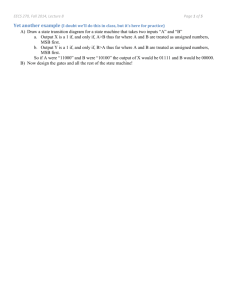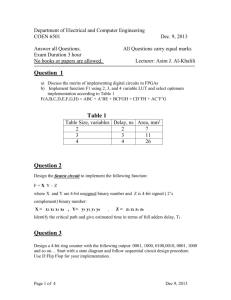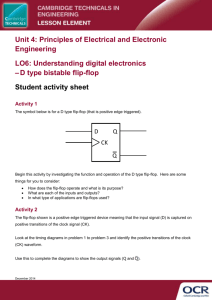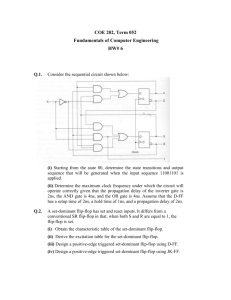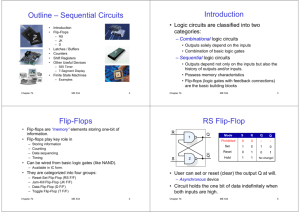PHYSICS 201 - La Salle University
advertisement
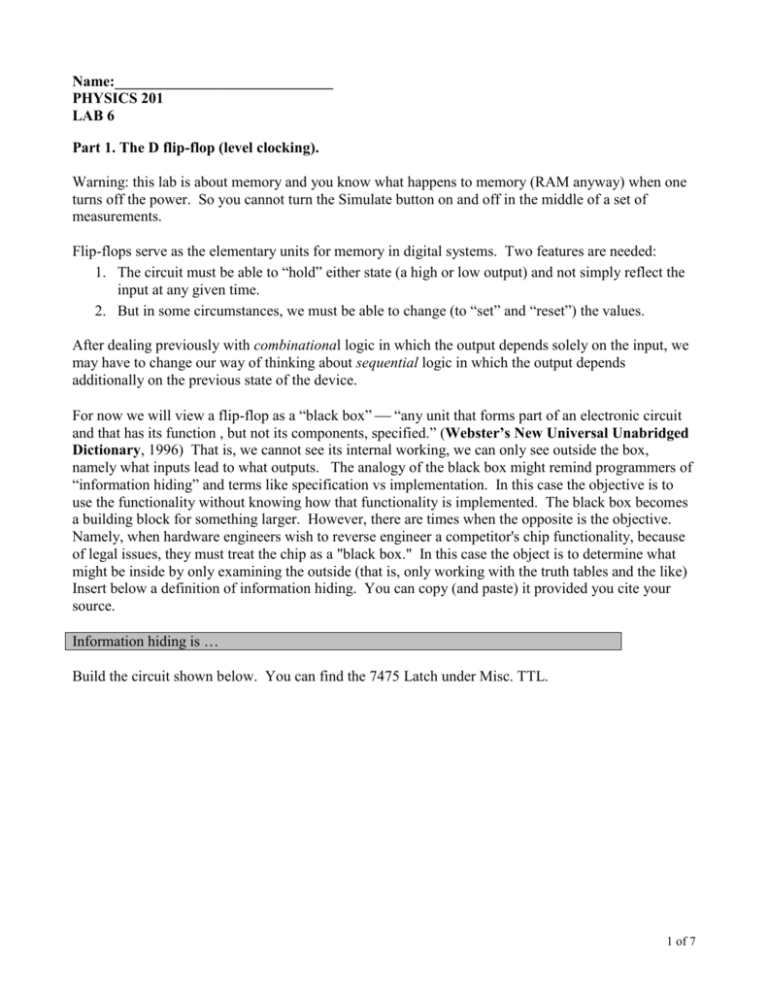
Name:_____________________________ PHYSICS 201 LAB 6 Part 1. The D flip-flop (level clocking). Warning: this lab is about memory and you know what happens to memory (RAM anyway) when one turns off the power. So you cannot turn the Simulate button on and off in the middle of a set of measurements. Flip-flops serve as the elementary units for memory in digital systems. Two features are needed: 1. The circuit must be able to “hold” either state (a high or low output) and not simply reflect the input at any given time. 2. But in some circumstances, we must be able to change (to “set” and “reset”) the values. After dealing previously with combinational logic in which the output depends solely on the input, we may have to change our way of thinking about sequential logic in which the output depends additionally on the previous state of the device. For now we will view a flip-flop as a “black box” “any unit that forms part of an electronic circuit and that has its function , but not its components, specified.” (Webster’s New Universal Unabridged Dictionary, 1996) That is, we cannot see its internal working, we can only see outside the box, namely what inputs lead to what outputs. The analogy of the black box might remind programmers of “information hiding” and terms like specification vs implementation. In this case the objective is to use the functionality without knowing how that functionality is implemented. The black box becomes a building block for something larger. However, there are times when the opposite is the objective. Namely, when hardware engineers wish to reverse engineer a competitor's chip functionality, because of legal issues, they must treat the chip as a "black box." In this case the object is to determine what might be inside by only examining the outside (that is, only working with the truth tables and the like) Insert below a definition of information hiding. You can copy (and paste) it provided you cite your source. Information hiding is … Build the circuit shown below. You can find the 7475 Latch under Misc. TTL. 1 of 7 V1 5V J1 U2A 2 1D1 Key = D 3 J2 13 1D2 1EN1 U1 1Q1 16 ~1Q1 1 1Q2 15 ~1Q2 14 + 0.000 V DC 10M R1 1.0k 7475N Key = E The real 7475 chip has 4 data latches; the circuit simulation above shows only two of them. The D Latch is also known as a bistable latches or a D flip-flop. The D flip-flop has two inputs, D (for data) and EN (for enable – but also sometimes called the clock). The two data inputs share the same Enable input. Finally the D flip-flop has two ouputs Q and Q´. The two outputs Q and Q´ should be the inverses of one another (that’s what the prime means), this is standard for all types of flip-flops, and any time Q and Q´ are not inverses the flip-flop will be considered to be in an undesired state. The truth table for a single D flip flop is D 0 1 X EN 1 1 0 Q 0 1 Q0 Q´ 1 0 Q0´ The table above says that if EN=1, then Q is whatever D is. This is the write action (“set” if D=1 or “reset” if D=0). On the other hand, if EN=0, then Q=Q0, where Q0 stands for the previous value of Q. Thus Q stays whatever it was before. This is the “hold” or “no change” action. Use your circuit to fill in the table below. Identify the type as set, reset or no change. (Be careful, just because Q does not change does not mean that the action type was “no change.” You could be writing a 1 on top of another 1.) E 1 0 0 1 1 0 1 0 0 1 1 1 1 D 0 0 1 1 0 0 0 0 1 1 0 1 0 Q Q΄ Type 2 of 7 Part 2. The D Flip-flop (edge triggering). Above we saw that the enable (clock) input determined if/when we could write and the data input determined what we wrote. The flip-flop above is said to be “level sensitive,” which means that the time when one can set or reset the flip-flop’s value is determined by the enable’s (clock’s) level (whether it is high or low). If the data input does not have a consistent value while the clock is high, the changes in the input will be reflected in the flip-flop’s output. The change may be a desired change in the data input (but such changes take time), or it may be an undesired fluctuation (noise). If we shrink down the interval during which writing is allowed, then we reduce the amount of time that our data input has to have the desired value. Of course, we time this brief writing period after the data input line has settled down to the desired value. This is the idea behind edge triggering. Writing is enabled not by the level of the clock input (e.g. when CLK=1) but rather by the edge of the clock (e.g. when CLK changes from 0 to 1). The change from 0 to 1 is referred to as the positive edge, whereas the change from 1 to 0 is called the negative edge. Build the circuit below with a 7474 chip, which houses two D flip-flops. V1 5V 4 J1 U3A U1 ~1PR 2 1Q 5 ~1Q 6 1D + 0.000 V Key = D 3 J2 1CLK R1 1.0k DC 10M ~1CLR 1 7474N Key = E Set the value of D and C to the values shown in the table below. CLK 0 0 1 1 1 0 1 0 0 1 1 D 0 1 1 0 1 1 1 1 0 0 1 Q Q΄ Type 3 of 7 1 1 0 1 1 0 1 0 1 1 1 0 0 0 Does one write (set or reset) on the positive edge or the negative edge in the above circuit? How do you know? What is DDR SDRAM? What does it have to do with the information above? Occasionally one wants to override the clock, that is, to set or reset the value without waiting for the appropriate time. This is the function of CLR and PRE pins. In the circuit below we have added switches to these pins. V1 5V J3 Key = J1 P 4 U3A U1 ~1PR Key = J2 D 2 + 1Q 5 ~1Q 6 1D 5.000 U2 + 3 Key = E J4 1CLK 0.000 V R1 1.0k V DC 10M ~1CLR 1 7474N DC 10M R2 1.00K Key = C Determine which pin corresponds to setting (independent of the clock) and the values of the pins to obtain that action. Do the same for resetting. It is now possible to have an undesired state, what pin values give it? Finally what pin values correspond to normal functioning (i.e. writing determined by the clock). This undesired state of this chip is not properly simulated in Electronics Workbench, so answer this question by examining the truth table. Go to Help/Component Reference, the go to functions and 74xx74. 4 of 7 Action Pin values CLR CLK D PR Setting (independent of clock) Resetting (independent of clock) Undesired state Normal functioning Part 3. The D Flip-flop (gate version). Below you see a circuit with the gate version of a D flip-flop (D_FF Under Misc. Digital). Find the output corresponding to the inputs in the table below. Instead of the resistor with a voltmeter across it to determine the output state, the circuit below uses an LED (light-emitting diode, found under diodes next to the Resistors). A diode is a circuit element that only allows current to flow in one direction. They can be considered to be off (no current flowing through) or on (current flowing through). Lightemitting diodes have the added feature that they light up when current is passing through them. This provides a visual indication of the state of the output. The voltage drop of 5 volts across a diode would burn out the diode. Hence we need to place a resistor in series, so that some of the voltage is dropped across the resistor. That resistance should not be too high, however, since the LED doesn’t light if it does not have sufficient current passing through it (approx. 10 mA). V1 5V J1 U1 SET D Key = J2 D Q CLK ~Q D_FF Key = E CLK 1 0 1 0 0 1 1 1 0 D 1 1 1 1 0 0 0 1 1 D2 D1 RESET Q R1 100 R2 100 Q’ 5 of 7 1 1 Is this flip-flop edge triggered? How do you know? Part 4. Parallel loading Register. Build the circuit shown below. It is a four-bit register. It adds some additional circuitry to specify when the inputs values are accepted. Under what circumstances does the register accept the input values A, B, C and D? Be specific. V1 5V J1 Key = A J2 J3 J4 J5 J6 Key = B Key = C Key = D Key = L Key = T U8 NOT U5 AND2 U6 AND2 U9 AND2 U7 OR2 U10 AND2 U12 AND2 U11 OR2 U14 OR2 U1 Q CLK U3 SET D ~Q Q CLK RESET SET D ~Q Q CLK RESET D_FF U4 SET D U18 D ~Q Q CLK RESET D_FF U16 AND2 U17 OR2 U2 SET U15 AND2 U13 AND2 ~Q DCD_HEX RESET D_FF D_FF Load in the binary number corresponding to the hexadecimal value B and have it showing on the display. Paste a copy of it into this document. Part 5. Add accumulators to ALU. Finish the circuit AdderWithRegisters. It has one enter the first number into a 4-bit register, then second number into a second 4-bit register. The outputs of the flipflops become the inputs of the adders. Connect the displays to outputs of the registers and to the output of the adders. Paste a copy of the circuit displaying 2 + 3 = 5. 6 of 7 Part 6. Some general questions and definitions. Distinguish between ROM and RAM. Discuss in general terms the use of each in the operation of a computer. Briefly define PROM, EPROM, EEPROM, Flash Memory, firmware, DRAM, SRAM and cache. (Defining an acronym requires a little more than just spelling it out. Your definitions, though brief, should bring out the distinctions in these terms. If you had to look it up, cite your source.) 7 of 7
